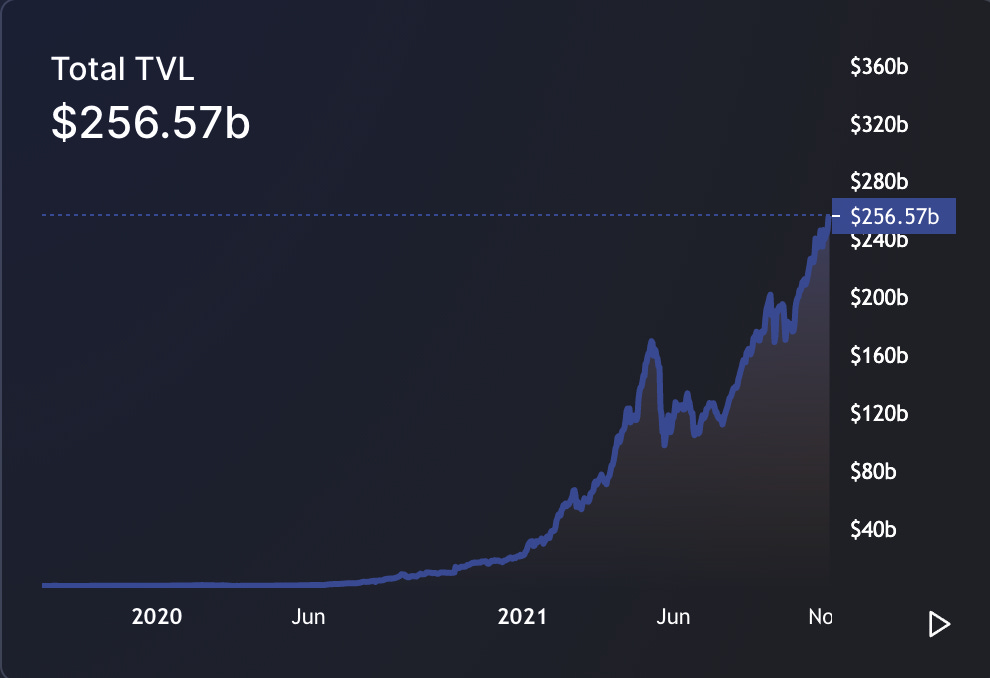As the saying goes, you can’t make omelettes without breaking some eggs. For the DeFi ecosystem, the broken egg running net total [via protocol exploits] has reportedly reached a dollar value of $680m year-to-date [sigh]. So it’s no surprise that after the Squid Game coin rug-pool [aka scam] this week, the ‘Wild West’ depiction of DeFi has been regaining momentum… But then, DeFi TVL acceleration has also been picking up speed, soaring as the ‘grande omelette’ of the analogy, now at $256bn.
In spite of some grumbles, it’s been another cracking week [ouch] in digital asset land, with VCs pouring more money into the space, Avalanche launching their own $200m incubator fund and Zuckerbot’s ‘META’ rebrand throwing gallons o’ fuel on the gaming / NFT fire. If you thought October was exciting, wait until we’re looking back on November… Welcome back to DeFi Insights!
1. The Wild Wild West
It is ‘wild’ that there have been 70 DeFi exploits so far this year, accounting for $680m of stolen funds. However, the fact that the exploits were initially over double that amount [$1.4bn] with $760m of assets subsequently returned by the hackers, is perhaps even more remarkable. We have commented before on the interesting feature in DeFi where stolen funds are occasionally returned by ‘white hat’ hackers - as was the case for Poly Network’s $612m hack returned in full. It’s sometimes hard to remember DeFi is still a nascent, experimental emerging market and with creative tools like flash loans providing ammunition for disruption, battle-testing smart contract code is critical. As a case in point, take C.R.E.A.M. finance, which has been hacked twice since we began writing DeFi Insights (in addition to the February hack).
However, while ‘Wild West’ is not inaccurate in terms of the lack of current regulatory oversight, it doesn’t highlight the level of advanced innovation currently taking place in decentralized finance. Also, returning to the initial analogy of omelettes and breaking eggs, the $680m impact shrinks somewhat when placed alongside the ~$230bn [DeFi Llama] of total value locked [TVL] added to the DeFi ecosystem since the beginning of 2021.
Yes, we are still in the ‘construction phase’ of on-chain finance and as G. Gensler helpfully points out, there is considerable room for oversight. Yet while the community waits patiently for the SEC to “bring the digital currency market under its investor protection framework”, policy proposals [Coinbase], risk warnings and the ‘DYOR’ slogan are still the best protection for retail newcomers.
2. Everyone wants a piece of the crypto pie…
… and it’s a race to the top. From VCs throwing $6.5bn at new projects in Q3 alone, to the Commonwealth Bank of Australia (CBA) partnering with Gemini exchange to capture slices of the crypto trading revenue pie, it’s all go go go. Also, L1s are not just launching DeFi builder incentive funds anymore; Avalanche just unveiled their $200m ‘Blizzard’ (not the game studio) incubator fund to sit alongside their ‘Rush’ program launched back in August. Arguably MicroStrategy wants the biggest piece of the pie though and have accordingly increased their Bitcoin holdings to 114k BTC or ~$7bn. Note: MicroStrategy’s market cap today is $8.28bn, although DCG just raised $700m at a $10bn valuation, so…
As for exchanges themselves, Coinbase are flexing their product offerings to now include loans of up to $1m against Bitcoin holdings (they only just unveiled plans for an NFT trading platform), while Binance is dropping a casual $116m initiative to grow the French crypto ecosystem. Note: “Europe has the biggest cryptocurrency economy in the world, receiving over $1 trillion worth of cryptocurrency over the last year, which represents 25% of global activity” [Chainalysis ‘Geography of Cryptocurrency’ report pg 49] and this initiative with French Fintech is a strategically-focused push into the area. As we have said before, it’s an exciting time in digital assets but companies are compelled to release innovative product features all the time to drive growth via new users and consolidation of their positions in the space. Keep an eye on Kraken too.
3. Is the Metaverse really just bs?
You know the term ‘Metaverse’ is hitting the mainstream when Mark Zuckerberg coordinates a full rebrand / strategy shift towards the ‘new world’ and PC Gamer chime in with a perfectly contrarian view.. The first few paragraphs of the article are immensely amusing, but a partially valid point is made: “The metaverse is bullshit because it already exists, and it's called the internet”.
Except that statement isn’t quite true. Web3 facilitates the ever-expanding Metaverse and is an enhancement of the internet, with verifiable, trustless, self-governing, permissionless, distributed and robust and stateful characteristics. Web3 applications run on blockchains that are facilitated by peer-to-peer nodes; a decentralized internet. Arguably, Zucc’s ‘Meta’ presentation pushed some sceptics over the edge, but it also led to major excitement into existing Metaverse projects, as it was a household name / leading blue-chip confirmation that ‘yes, this is a real thing’.
Perhaps the Metaverse won’t be one thing, but rather a “conceptual collection of open worlds and settings joined by interoperable assets and experiences” as Decrypt suggest. To some extent, it doesn’t matter how it is defined, it’s about how it’s experienced, and with so many of us engaged in screen time all hours of the day, the experience is gradually becoming more and more… immersive. Time to become a ‘solarpunk’.
And now for something that reflects quite how mainstream crypto is going:
… brought to you by Alkemi Network
Alkemi Network is building an on-chain liquidity network with a suite of tools and products that serve as onramps for everyone to participate in decentralized finance. Access subsidized borrowing rates on the Alkemi Earn platform, use the ‘Verified’ digital asset pool to conduct borrowing and lending within a trusted-counterparty liquidity environment. Be compliant, use Alkemi Network.





